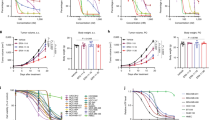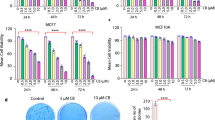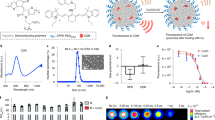Abstract
Nitroreductase (NTR)-mediated selective cell ablation using the prodrug CB1954 has been achieved in vivo by targeting the nitroreductase gene to the luminal cells of the mammary gland in transgenic mice. We report that the cell ablation occurs very rapidly, starting as early as 7 h after administration of the prodrug. By cross-breeding the BLG-NTR transgenic mice to a p53-deficient mouse strain, we have generated BLG-NTR transgenic mice on a p53 null background and tested NTR-mediated cell ablation in these mice. The transgenic mice lacking a functional p53 gene showed cell ablation at a similar level compared with p53 wild-type transgenic mice, showing that functional p53 is not required for CB1954-NTR mediated cell death. These results provide further support for using this system in anti-cancer therapy.
This is a preview of subscription content, access via your institution
Access options
Subscribe to this journal
Receive 12 print issues and online access
$259.00 per year
only $21.58 per issue
Buy this article
- Purchase on Springer Link
- Instant access to full article PDF
Prices may be subject to local taxes which are calculated during checkout




Similar content being viewed by others
References
Moolten FL . Tumor chemosensitivity conferred by inserted herpes thymidine kinase genes: paradigm for a prospective cancer control strategy Cancer Res 1986 46: 5276–5281
Moolten FL, Wells JM, Heyman RA, Evans RM . Lymphoma regression induced by ganciclovir in mice being a herpes thymidine kinase transgene Hum Gene Ther 1990 1: 125–135
Chambers R et al. Comparison of genetically engineered herpes simplex viruses for the treatment of brain tumors in a scid mouse model of human malignant glioma Proc Natl Acad Sci USA 1995 92: 1411–1415
Black ME, Newcomb TG, Wilson HMP, Loeb LA . Creation of drug-specific herpes simplex virus type 1 thymidine kinase mutants for gene therapy Proc Natl Acad Sci USA 1996 93: 3525–3529
Izquierdo M et al. Human malignant brain tumor response to herpes simplex thymidine kinase (HSVtk)/ganciclovir gene therapy Gene Therapy 1996 3: 491–495
Borrelli E et al. Transgenic mice with inducible dwarfism Nature 1989 339: 538–541
Canfield V, West AB, Goldenring JR, Levenson R . Genetic ablation of parietal cells in transgenic mice: a new model for analyzing cell lineage relationships in the gastric mucosa Proc Natl Acad Sci USA 1996 93: 2431–2435
Cheng C et al. Unique spectrum of activity of 9-[(1,3-dihydroxy-2-propoxy)methyl]-guanine against herpesviruses in vitro and its mode of action against herpes simples virus type 1 Proc Natl Acad Sci USA 1983 80: 2767–2770
Clark AJ et al. Selective cell ablation in transgenic mice expressing E. coli nitroreductase Gene Therapy 1997 4: 101–110
Bridgewater JA et al. Expression of nitroreductase enzyme in mammalian cells renders them selectively sensitive to killing by the prodrug CB1954 Eur J Cancer 1995 31A: 2362–2370
Drabek D, Guy J, Craig R, Grosveld F . The expression of bacterial nitroreductase in transgenic mice results in specific cell killing by the prodrug CB1954 Gene Therapy 1997 4: 111–118
Knox RJ, Friedlos F, Boland M . The bioactivation of CB1954 and its use as a prodrug in antibody directed enzyme pro-drug therapy Cancer Metast Rev 1993 12: 195–212
Wallace H, McLaren K, Al-Shawi R, Bishop JO . Consequences of thyroid hormone deficiency induced by the specific ablation of thyroid follicle cells in adult transgenic mice J Endocrinol 1994 143: 107–120
Bridgewater JA et al. The bystander effect of the nitroreductase/CB1954 enzyme/prodrug system is due to a cell-permeable metabolite Hum Gene Ther 1997 10: 709–717
Ko LJ, Prives C . p53: Puzzle and paradigm Genes Dev 1996 10: 1054–1072
Lowe SW et al. p53 is required for radiation induced apoptosis in mouse thymocytes Nature 1993 362: 847–849
Clarke AR et al. Thymocyte apoptosis induced by p53 dependent and independent pathway Nature 1993 362: 849–852
Gusterson B et al. Selective cell ablation in the mammary gland of transgenic mice Endocrine-Related Cancer 1997 4: 67–74
Greenblatt M, Bennett WP, Hollstein M, Harris CC . Mutations in the p53 tumor suppressor gene: clues to cancer etiology and molecular pathogenesis Cancer Res 1994 54: 4855–4878
Bursh W, Kleine L, Tenniswood M . Biochemistry of cell death by apoptosis Biochem Cell Biol 1990 68: 1071–1074
El-Deiry WS et al. WAF1/CIP1 is induced in p53-mediated G1 arrest and apoptosis Cancer Res 1994 54: 1169–1174
Lowe SW et al. p53 status and the efficacy of cancer therapy in vivo Science 1994 266: 807–810
Kasan MB et al. Participation of p53 in the cellular response to DNA damage Cancer Res 1991 51: 6304–6311
Malcomson RG et al. Apoptosis induced by γ-irradiation, but not CD4 ligation, of peripheral T lymphocytes in vivo is p53-dependent J Pathol 1997 181: 166–171
Author information
Authors and Affiliations
Rights and permissions
About this article
Cite this article
Cui, W., Gusterson, B. & Clark, A. Nitroreductase-mediated cell ablation is very rapid and mediated by a p53-independent apoptotic pathway. Gene Ther 6, 764–770 (1999). https://doi.org/10.1038/sj.gt.3300873
Received:
Accepted:
Published:
Issue Date:
DOI: https://doi.org/10.1038/sj.gt.3300873
Keywords
This article is cited by
-
Precise spatio-temporal control of rapid optogenetic cell ablation with mem-KillerRed in Zebrafish
Scientific Reports (2017)
-
A mammalianized synthetic nitroreductase gene for high-level expression
BMC Cancer (2009)
-
E. coli nitroreductase/CB1954 gene-directed enzyme prodrug therapy: role of arylamine N-acetlytransferase 2
Cancer Gene Therapy (2008)
-
Repeated cycles of Clostridium-directed enzyme prodrug therapy result in sustained antitumour effects in vivo
British Journal of Cancer (2006)
-
Antitumor immune responses mediated by adenoviral GDEPT using nitroreductase/CB1954 is enhanced by high-level coexpression of heat shock protein 70
Cancer Gene Therapy (2005)



